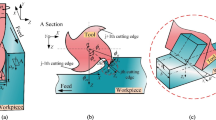Abstract
A new method is presented to predict milling forces synthetically. Firstly, the 3D simulation model of the milling process is established using the arbitrary Lagrangian–Eulerian finite element method. And the simulated accuracy is calibrated by milling tests. Then the simulation model is taken as a virtual milling test system to replace extensive real milling experiments. Secondly, the specific cutting coefficients in the mechanistic milling forces model are identified by the support vector regression method using the training sample generated from the established virtual milling test system. Lastly, this methodology was validated by the slot milling operation of 2024-T3 aluminum sheets. The results show that this new approach can dramatically eliminate the experimental machining work and achieve good estimation accuracy.
Similar content being viewed by others
References
Hu, F., Li, D.: Process planning and simulation strategies for perimeter milling of thin-walled flexible parts held by reconfigurable fixturing system. In: Werner, B. (ed.) Proceedings-3rd International Conference on Measuring Technology and Mechatronics Automation, vol. 2, pp. 922–926. IEEE Comput. Soc., Los Alamitos (2011)
Wang, L., Ke, Y., Huang, Z.: Experimental study on milling-force model in aviation aluminum-alloy. China Mech. Eng. 14(19), 1684–1686 (2003) (in Chinese)
Tandon, V., El-Mounayri, H.: A novel artificial neural networks force model for end milling. Int. J. Adv. Manuf. Technol. 18, 693–700 (2001)
Zuperl, U., Cus, F.: Tool cutting force modeling in ball-end milling using multilevel perceptron. J. Mater. Process. Technol. 153–154, 268–275 (2004)
Altintas, Y.: Manufacturing Automation, Metal Cutting, Machine Tool Vibration and CNC Design. Cambridge University Press, Cambridge (2000)
Ozel, T., Altan, T.: Process simulation using finite element method–prediction of cutting forces, tool stresses and temperatures in high speed flat end milling. Int. J. Mach. Tools Manuf. 40, 713–738 (2000)
Pantale, O., Bacaria, J.L., Dalverny, O., Rakotomalala, R., Caperaa, S.: 2D and 3D numerical models of metal cutting with damage effects. Comput. Methods Appl. Mech. Eng. 193, 4383–4399 (2004)
Jalili Saffar, R., Razfar, M.R., Zarei, O., Ghassemieh, E.: Simulation of three-dimension cutting force and tool deflection in the end milling operation based on finite element method. Simul. Model. Pract. Theory 16, 1677–1688 (2008)
Limido, J., Espinosa, C., Salaun, M., Lacome, J.L.: SPH method applied to high speed cutting modeling. Int. J. Mech. Sci. 49, 898–908 (2007)
Lee, B.Y., Tarng, Y.S.: Application of the discrete wavelet transform to the monitoring of tool failure in end milling using the spindle motor current. Int. J. Adv. Manuf. Technol. 15, 238–243 (1999)
Altintas, Y.: Prediction of cutting forces and tool breakage in milling from feed driver current measurements. J. Eng. Ind. 114(4), 286–392 (1992)
Vapnik, V.N.: The Nature of Statistical Learning Theory. Springer, Heidelberg (1995)
Vazquez, E., Walter, E.: Multi-output support vector regression. In: Van de Hof, P., Wahlberg, B., Weiland, S. (eds.) Proceedings of 13th IFAC Symposium on System Identification, Rotterdam, Netherlands, vol. 1, pp. 1195–1200 (2003)
Lee, Y., Oh, S., Choi, D.-H.: Design optimization using support vector regression. J. Mech. Sci. Technol. 22, 213–220 (2008)
Yan, H., Zhang, X., Li, Y.d.: Relation between a support vector machine and the least square method. J. Tsinghua Univ. (Sci. Technol.) 41(9), 77–80 (2001) (in Chinese)
Fang, N.: A new quantitative sensitivity analysis of the flow stress of 18 engineering materials in machining. J. Eng. Mater. Technol. 127, 192–196 (2005)
Milani, A.S., Dabboussi, W., Nemes, J.A., Abeyaratne, R.C.: An improved multi-objective identification of Johnson–Cook material parameters. Int. J. Impact Eng. 36, 294–302 (2006)
Johnson, W.K., Cook, R.: A constitutive model and data for metals subjected to large strains, high strain rates and high temperatures. In: Proc. 7th International Symposium on Ballistics, pp. 541–547 (1983)
ABAQUS Inc.: ABAQUS Analysis Userś Manual. ABAQUS Inc. (2009)
Van Leer, B.: Towards the ultimate conservative difference scheme. IV. A new approach to numerical convection. J. Comput. Phys. 23, 276–299 (1977)
Leseur, D.R.: Experimental investigations of material models for Ti-6Al-4V titanium and 2024-T3 aluminum. Technical report DOT/FAA/AR-00/25, US Department of Transportation, Federal Aviation Administration (2000)
Vaz, M. Jr., Owen, D.R.J., Kalhori, V., et al.: Modelling and simulation of machining processes. Arch. Comput. Methods Eng. 14, 173–204 (2007)
Zorev, N.N.: Inter-relationship between shear processes occurring along tool face and shear plane in metal cutting. In: International Research in Production Engineering, pp. 42–49. ASME, New York (1963)
Riviere-Lorphèvre, E., Filippi, E.: Mechanistic cutting force model parameters evaluation in milling taking cutter radial runout into account. Int. J. Adv. Manuf. Technol. 45, 8–15 (2009)
Junz Wang, J.J., Chang, H.C.: Extracting cutting constants via harmonic force components for a general helical end mill. Int. J. Adv. Manuf. Technol. 24, 415–424 (2004)
Wang, J., Jin, Q., Cao, L.: Support vector regression algorithm for multi-input multi-output systems. J. Tsinghua Univ. (Sci. Technol.) 47(s2), 1737–1741 (2007) (in Chinese)
Cristianini, N., Shawe-Taylor, J.: An Introduction to Support Vector Machines and Other Kernel-based Learning Methods. Cambridge University Press, Cambridge (2000)
Author information
Authors and Affiliations
Corresponding author
Additional information
Communicated by Konstantin A. Lurie.
Rights and permissions
About this article
Cite this article
Hu, F., Li, D. Modelling and Simulation of Milling Forces Using an Arbitrary Lagrangian–Eulerian Finite Element Method and Support Vector Regression. J Optim Theory Appl 153, 461–484 (2012). https://doi.org/10.1007/s10957-011-9927-y
Received:
Accepted:
Published:
Issue Date:
DOI: https://doi.org/10.1007/s10957-011-9927-y




